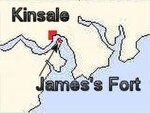Bastion fort in County Cork, Ireland
| James Fort | |
|---|---|
 Central fortification of James Fort Central fortification of James Fort | |
 Location of James Fort in Kinsale harbour Location of James Fort in Kinsale harbour | |
| Type | Bastion fort |
| Location | Castlepark peninsula, Kinsale harbour, County Cork, Ireland |
| Coordinates | 51°41′55″N 8°30′44″W / 51.6986°N 8.5122°W / 51.6986; -8.5122 |
| Built | 1602 (1602) |
| Governing body | Office of Public Works |
| National monument of Ireland | |
| Type | Guardianship |
| Reference no. | 525 |
| Description | Star-shaped-fort & blockhouse |
James Fort (Irish: Dún Rí Shéamuis) is an early 17th-century pentagonal bastion fort located on Castlepark peninsula in Kinsale harbour, County Cork, Ireland. Situated downstream from Kinsale on the River Bandon, the fort was built to defend the harbour and seaborne approaches of the town. Following the construction of Charles Fort on the opposite side of the harbour in the late 17th century, James Fort became known as the "old fort" (Irish: an Seandaingean). Listed as a protected National Monument, and managed by the Office of Public Works, the fort is open to visitors.
History

Before James fort was constructed, an earlier medieval fortification existed on the site. This fortification, named Castle Ny-Parke was occupied for a time by Spanish forces during the early part of the Siege of Kinsale (1601). It was captured however from the Spanish by Sir Richard Smyth who led the attacking English forces of Charles Blount, Lord Mountjoy.
Construction of James Fort commenced in 1602 - immediately after the Siege of Kinsale. The fort was named after James I of England and VI of Scotland, and was built to designs by Paul Ive (to replace and supplement the older medieval structure). Completed by 1607, the central structure was a half-bastioned four-sided stone fortification, surrounded by pentagonal earthworks to a bastion fort or star-shaped fort design. A hexagonal blockhouse was built on the water's edge - a water battery at the narrowest point in the channel.
As with Charles Fort on the other side of the harbour, James Fort was occupied by Jacobite forces during the Williamite War in Ireland. It was captured however in 1690 by Williamite forces, after being damaged by an explosion of gunpowder stores.
Though Charles Fort (the "new fort") was operated as a military garrison through to the early 20th century, James Fort (the "old fort") declined in use during the 18th century, and texts and maps describe it as a ruin by the 19th century.
Today
James Fort was subject to a number of archaeological excavations in the late 20th and early 21st centuries - including a survey commissioned by Dúchas (the Heritage Service) in 1998. The fort site is listed as a National Monument (number 525), and as such under "state guardianship". As of 2016, An Taisce (the National Trust for Ireland) listed the fort in an "at risk" category, noting that while it had been subject to preservation works, it required "a long-term conservation management plan to prevent future deterioration".
The James Fort site is publicly accessible, and visited both as a tourist attraction and as an amenity park (by walkers and runners).
References
- "Place Names Commission - James Fort / Old Fort / An Seandaingean". Irish Place Names Commission. Retrieved 5 October 2014.
- Mackenzie Semple, John (1937). "Charles Fort, Kinsale". Journal of the Society for Army Historical Research. 16. Society for Army Historical Research: 174. JSTOR 44226191.
- ^ "Discover Ireland - Historic Houses and Castles - James Fort Kinsale". Failte Ireland (Irish Tourist Board). Retrieved 5 October 2014.
- Stafford, Thomas (1810). Pacata Hibernia: or, A history of the wars in Ireland.
- Montgomery-Massingbred, Hugh, ed. (1976). Irish Family Records. ISBN 978-0-85011-050-0.
- Stephenson, Charles (2008). Servant to The King for His Fortifications: Paul Ive and The Practise of Fortification. p. 34.
- ^ "James's Fort, Kinsale, County Cork". Buildings of Ireland. National Inventory of Architectural Heritage. Retrieved 3 February 2017.
- Marix Evans, Martin (1998). The Military Heritage of Britain & Ireland. Andre Deutsch Ltd. p. 220. ISBN 0233000607.
- ^ "2003:325 - James Fort, Old-Fort, Cork". Excavations.ie. National Monuments Service, Department of Arts, Heritage & the Gaeltacht. Retrieved 3 February 2017.
- Goode, Dominic. "Fortified Places - James Fort". Fortifiedplaces.com - Bastioned fortification resource.
- Smith, Charles (1815). The ancient and present state of the county and city of Cork (Volume 2). p. 209.
- Townsend, Horace (1815). Statistical survey of the county of Cork, with observations on the means of improvement. Dublin Society. p. 21.
- National Monuments in State Care: Ownership & Guardianship - Cork (PDF) (Report). National Monuments Service. 4 March 2009. p. 5. Retrieved 30 January 2020.
- "James's Fort, Kinsale". An Taisce. Archived from the original on 3 February 2017.
- "Autumn League #3: James Fort Kinsale - Results and Report". Cork Orienteering Club. 10 September 2015.
- "Cork: Splendid views of Kinsale attractions". Irish Examiner. 20 August 2012.